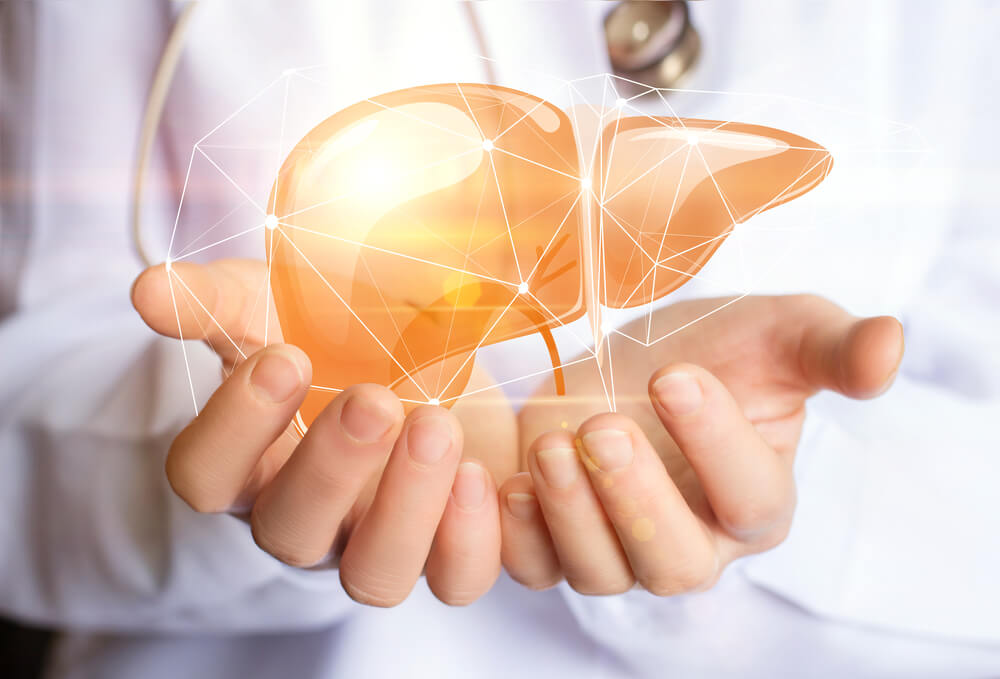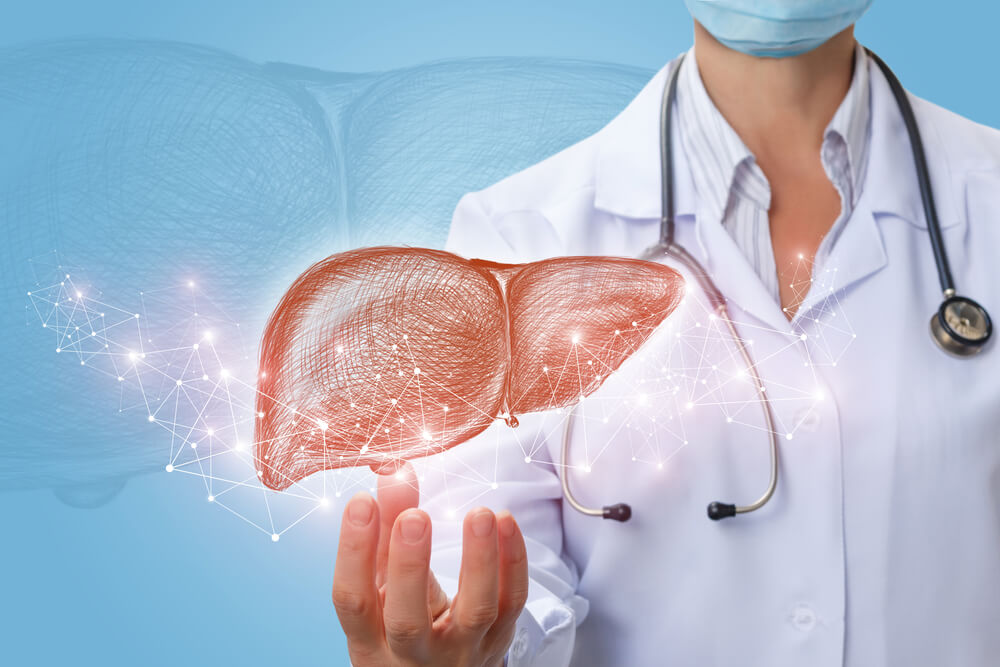About the liver
- The liver is the most important metabolic organ in the body. It is a gland weighing about 1.5 kg located in the upper-right abdomen, below the diaphragm, that is, below the right costal arch, which protect it against trauma.
- In the case of weakness of the liver, and without adequate medical support, you would not survive for more than two days. This testifies to the essential nature of the liver.
- When you think of the liver, you can definitely imagine it as a biochemical laboratory. In fact, the liver has over 500 functions in the body:

- Blood proteins are formed in the liver, and they participate in maintaining the balance of fluid between the intracellular and extracellular space (albumins). The liver also forms proteins from which antibodies are developed – the component of the immune response (globulins) and proteins that play a role in blood clotting (fibrinogen)
- Further, coagulation factors are created in the liver
- All fat soluble vitamins are deposited in the liver
- The metabolism of the energy fuel of a body – glucose largely takes place in the liver
- The metabolism of oligoelements, like iron and copper, takes place in the liver
- The metabolism of bile pigments
- Detoxification from alcohol
- Detoxification from medicines and other metabolites – ammonia, etc.
In every condition when liver function is compromised, several symptoms and signs arise as a result of disorders of the aforementioned liver functions.
Liver diseases
The most common conditions are inflammatory processes of the liver – hepatitises.
- Hepatitis is an inflammatory liver disease that can be caused by a number of factors – toxins, drugs, alcohol, viruses, bacteria, fungi … it is characterized by the destruction of liver cells and the release of intracellular enzymes, which is laboratory-recorded with at least 10x higher levels of liver enzymes in the serum.
- In clinical practice, the most common are viral hepatitises caused by hepatitis A, B, C, D, E viruses. The greatest potential for damage is shown by Hepatitis B and C viruses, which are transmitted directly, through blood, sexual contact, and transplacentally. They have a tendency towards
Any chronic inflammatory condition over time leads to the replacement of the liver parenchyma with dysfunctional connective tissue (liver fibrosis) and eventually, a more severe degree – cirrhosis. As the cirrhosis progresses, the signs of liver insufficiency, or weakness, appear. At first, the body succeeds in compensating it, but as the process progresses and takes hold, this weakness becomes decompensated to the development of fatal complications. It should be noted that hepatitis B and C viruses are potentially oncogenic, or can cause liver cancer.
Symptoms of liver dysfunction are as follows:
- Non-specific – exhaustion, fatigue, nausea, vomiting urge, pain in the upper right part abdomen
- Bright, fatty stool – due to disturbed metabolism of bile pigments
- Weight loss
- Collection of free fluid in the body, which is manifested by foot swelling in mild disorders and abdominal swelling in more pronounced disorders, the presence of fluid in the cavity between two layers of the pulmonary pleaurae that can seriously impair breathing or the presence of fluid in the pericardium which can lead to immediate death.
- Blood clotting disorder, which is exhibited by bleeding in the skin and subcutaneous tissue, and with more pronounced lack of the coagulation and fibrinogen factors, bleeding in the internal organs-blood in the stool, vomiting, coughing up sanies or fresh blood, bleeding in joint cavities, which may be fatal such as intracranial bleed
- Due to the inability to synthesize antibodies, the body is susceptible to infections of different etiologies – bacteria, viral, fungal, which are often non-responsive to therapy
- Intoxication with toxic products, mostly ammonia – which has a toxic effect on the central nervous system
- Psychological symptoms

Liver regeneration – when and how?
- We have all heard that the liver has a high regenerative potential, but with the progression of damage, this potential is reduced to a minimum. Therefore, in the case of diagnosed diseases or damages to the liver, it is necessary to remove the causes that led to it in time, to prevent the development of complications and do liver regeneration
- In advanced stages, the only survival chance is liver transplantation, and statistics show that the chance that the liver of an identical twin is a match is only 25%. In other cases, the chance to find an adequate donor is less than 1%.
- For these reasons, regenerative treatment must be started in time to maximize the potential of liver renewal and to prevent the development of complications.
DIAGNOSTIC PART
It aims at assessing the degree of liver damage, complications, and metabolic disorders in the body, as well as to diagnose possible comorbidities (additional conditions). It consists of:
- Detailed taking of a patient’s account of their medical history- where we collect the necessary information about medical history, the existence of chronic diseases, the predisposition to certain diseases, the patient’s lifestyle and so on
- Detailed physical examination “from head to toe”
- Internist examination
- Complete laboratory test of blood and urine – we get an insight into whether there is an inflammatory syndrome and its extent, we assess the synthetic and metabolic function of the liver, kidney, lipid status, mineral status, coagulation status, hormonal status
- Virology with a special emphasis on viral hepatitis causes – hepatitis B and C viruses – genotyping (determining the type of virus), and quantitation (determining the amount of virus) are done – these parameters are useful later as good prognostic indicators of the success of treatment
- Ultrasound abdomen examination – visualization gives us data on the condition of the liver, its size and the presence of complications
- Additional radiological diagnostics depending on the indications
- Specialist examinations – cardiologist, endocrinologist, neurologist …
THERAPY PART
- Antiviral therapy- In the case of diagnosed viral hepatitis, it is first necessary to treat viral hepatitis with antiviral drugs that prevent replication, that is, further propagation of the virus and allow for its eradication. The therapeutic protocol is adapted to the genotype of the virus, but also the presence/absence of complications such as liver fibrosis or cirrhosis
- Hepatoprotective therapy- One of the essential parts of the treatment is a therapy that will improve liver function, accelerate liver detoxification, and provide the liver with adequate protection.
- Metabolic therapy – To prevent complications caused by liver damage on other organ systems, it is necessary to start a therapy that will stimulate metabolic processes in the body, accelerate the work of the digestive organs, protect heart and CNS.
- Regenerative therapy- using the most up-to-date methods with high regenerative potential, such as cytokines or secretomes, it allows regeneration of damaged liver parts, but only after reducing inflammation
- Prevention of complications – prevention of cirrhosis, hypoproteinemia, hypoalbuminemia, encephalopathic complications, complications with kidneys,
- Physiotherapy – physiotherapy procedures serve to improve circulation, eliminate toxins, stimulate metabolic processes at the cell level. They also reduce oxidative stress and promote oxygenation at the level of all tissues.

